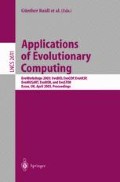Abstract
Our long-term goal is to evolve neural controllers which reproduce in behaving robots the kind of phonotaxis behaviour seen in real animals, such as crickets.We have previously studied the evolution of neural circuitry which, when implanted in a Braitenberg type 2b vehicle, promoted phototaxis behaviour in the form of movement towards flashing lights of different frequencies. (It was simpler to study light-driven than acoustic-driven behaviour.) Since this is not truly sequential behaviour, we now describe new work to discriminate between particular mark-space ratio patterns of the same basic (flash or on-o.) frequency. The next step will be to integrate the two behaviours so that robot taxis is driven by a signal with temporal structure closer to that of the cricket ‘song’.
Access this chapter
Tax calculation will be finalised at checkout
Purchases are for personal use only
Preview
Unable to display preview. Download preview PDF.
References
Braitenberg, V. (1984). Vehicles: Experiments in Synthetic Psychology. Cambridge, MA: MIT Press.
Bugmann, G. (1997). Biologically plausible neural computation. BioSystems 40 (1–2), 11–19.
R. I., R. L. B. French, and T. W. Scutt (2000). Arbib: An autonomous robot based on inspirations from biology. Robotics and Autonomous Systems 31 (4), 247–274.
Floreano, D. and C. Mattiussi (2001). Evolution of spiking neural controllers for autonomous vision-based robots. In T. Gomi (Ed.), Evolutionary Robotics IV, pp. 38–61. Berlin, Germany: Springer-Verlag.
French, R. L. B. and R. I. Damper (2002). Evolution of a circuit of spiking neurons for phototaxis in a Braitenberg vehicle. In Proceedings of Simulation of Adaptive Behavior 2002-From Animals to Animats 7, Edinburgh, UK, pp. 335–344.
Hawkins, R. D. and E. R. Kandel (1984). Is there a cell biological alphabet for simple forms of learning? Psychological Review 91 (3), 375–391.
Koch, C. (1998). Biophysics of Computation: Information Processing is Single Neurons. Cary, NC: Oxford University Press USA.
Kortmann, L. J. (1998). Evolving phonotoaxis in a robot cricket-an investigation in bio-robotics. Master’s thesis, University of Groningen, The Netherlands and University of Edinburgh, Scotland.
Lund, H. H., B. Webb, and J. Hallam (1997). A robot attracted to the cricket species Gryllus bimaculatus. In P. Husbands and I. Harvey (Eds.), Proceedings of Fourth European Conference on Artificial Life,ECAL’97, Brighton, UK, pp. 246–255. Cambridge, MA: MIT Press/Bradford Books.
McCulloch, W. S. and W. Pitts (1943). A logical calculus of the ideas immanent in nervous activity. Bulletin of Mathematical Biophysics 5, 115–133.
Reeve, R. and B. Webb (2002). New neural circuits for robot phonotaxis. In Proceedings of EPSRC/BBSRC International Workshop on Biologically-Inspired Robotics: The Legacy of W. Grey Walter, Bristol, UK, pp. 225–232.
Webb, B. and T. Scutt (2000). A simple latency-dependent spiking-neuron model of cricket phonotaxis. Biological Cybernetics 82 (3), 247–269.
Author information
Authors and Affiliations
Editor information
Editors and Affiliations
Rights and permissions
Copyright information
© 2003 Springer-Verlag Berlin Heidelberg
About this paper
Cite this paper
Damper, R.I., French, R.L.B. (2003). Evolving Spiking Neuron Controllers for Phototaxis and Phonotaxis. In: Cagnoni, S., et al. Applications of Evolutionary Computing. EvoWorkshops 2003. Lecture Notes in Computer Science, vol 2611. Springer, Berlin, Heidelberg. https://doi.org/10.1007/3-540-36605-9_56
Download citation
DOI: https://doi.org/10.1007/3-540-36605-9_56
Published:
Publisher Name: Springer, Berlin, Heidelberg
Print ISBN: 978-3-540-00976-4
Online ISBN: 978-3-540-36605-8
eBook Packages: Springer Book Archive

